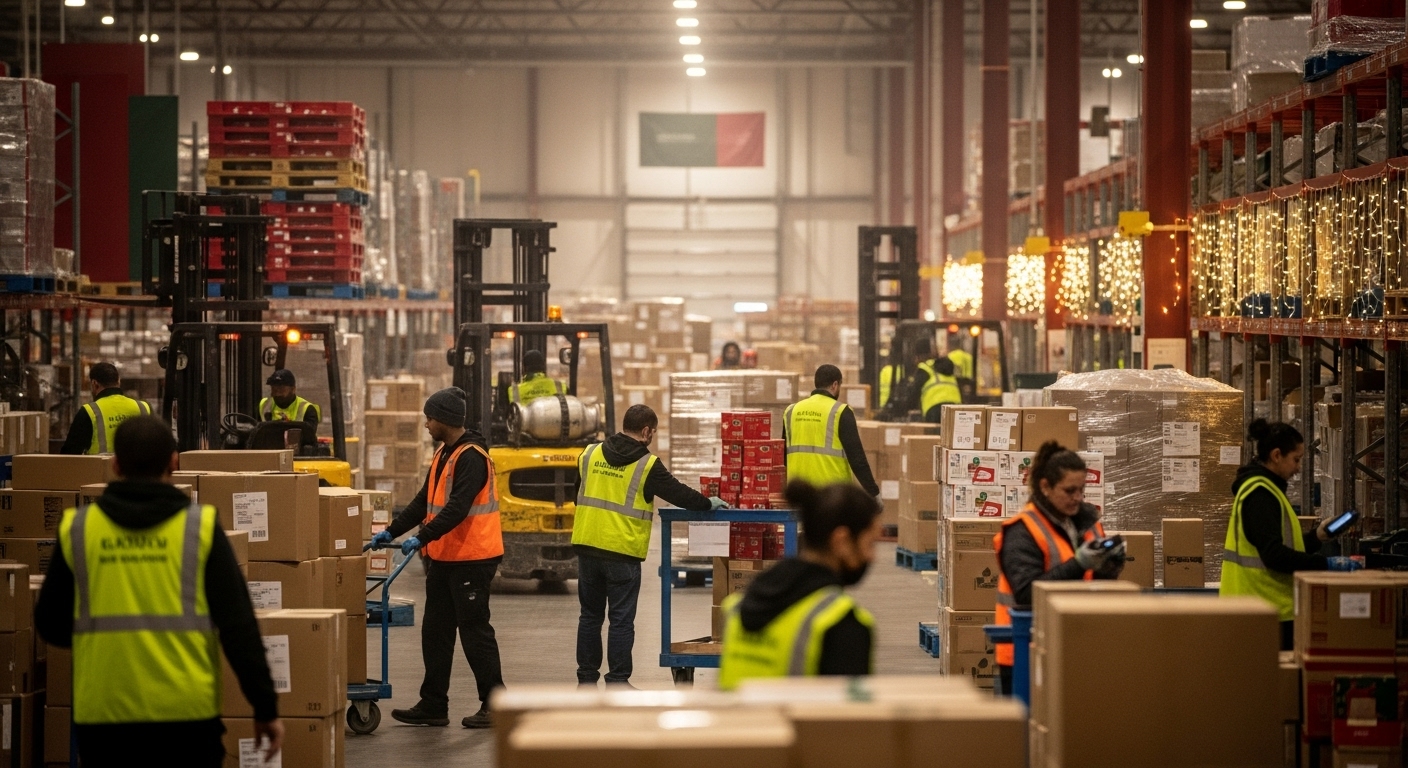Real World Lessons in Peak Season Staffing

Real World Lessons in Peak Season Staffing
The 2025 holiday season forecast is uncertain. Retailers, warehouses, and logistics operations are facing tighter budgets, inflation pressures, and changing consumer behavior. These dynamics are reshaping how companies approach peak season staffing.
According to recent reports:
- Mastercard projects 3.6% year-over-year retail sales growth between November 1 and December 24, with strong demand in in-store and digital shopping.
- PwC’s 2025 Holiday Outlook finds that while shoppers still plan to spend, average household holiday budgets may dip up to 5% due to inflation and cautious optimism.
Smart, flexible peak season staffing strategies are essential in this environment. Below are five lessons companies can apply to improve how they source, manage, and support peak season workers during the busiest time of year.
Lesson 1: Start hiring before competition tightens
The problem:
Many teams wait until mid-November or later to begin staffing up, assuming they’ll find the workers they need when the rush begins. But by then, the labor market is crowded with other employers doing the same. Data from iCIMS shows job postings in retail and fulfillment spike early in Q4, while actual hires lag behind, suggesting that demand for seasonal workers often outpaces employer readiness.
Hiring too late forces companies into reactive decisions, accepting underqualified workers, rushing onboarding, or losing top talent to competitors who moved earlier.
Fix:
Open your seasonal recruiting window earlier. Build a pipeline in October or sooner so you have time to screen, schedule, and train before the pressure hits. Early planning increases your odds of finding the right workers, without the chaos. Starting early is also key to securing the best options for peak season help and meeting peak demands.
Lesson 2: Don’t mistake volume for value
The problem:
Holiday hiring often turns into a numbers game: how many people can you get through the door before Black Friday hits? But quantity without quality creates more problems than it solves. When businesses bring on too many seasonal workers without the right skills or preparation, it leads to high absenteeism, lower productivity, and critical gaps in coverage at the worst times.
According to Inbound Logistics, 65% of companies that combined automation and seasonal hiring still struggled with fulfillment delays during the 2024 peak season, largely due to mismatched staffing and training challenges.
That’s because headcount alone doesn't ensure shift success. Without dependable workers who show up on time, follow instructions, and move efficiently, you’re not solving for peak, you’re just multiplying the risk.
Fix:
Hire fewer, but better. Focus on dependable workers who’ve been trained or tested before the holiday crunch. Pilot short shifts early, identify top performers, and give them first access to high-priority hours. This ensures your staffing investment supports reliable peak season labor and helps scale for peak season with fewer setbacks.
Lesson 3: Burnout isn’t just bad morale, it’s a business risk
The problem:
Without enough backup labor, core staff take the brunt of peak workloads. That means more overtime, skipped breaks, extended shifts, and added responsibilities, especially in warehouses, event setups, and high-volume retail.
Fatigue among workers leads to mistakes, missed deliveries, inventory issues, and elevated injury risk. In customer-facing roles, it results in slower service, negative reviews, and brand damage. The cost of overworking your team can far outweigh the cost of flexible supplemental support.
Fix:
Build a supplemental layer of flexible staff to handle high-volume periods. Whether it’s peak temp staffing for fulfillment or last-mile deliveries, using additional peak hiring solutions can preserve team energy and meet peak demand without sacrificing performance.
Lesson 4: Scheduling must match real-world conditions
The problem:
Even if you hire enough people, rigid shift schedules often cause breakdowns when demand surges or availability changes. Workers increasingly want (and expect) control over their shifts, especially during the holidays when personal obligations are high. Meanwhile, managers need real-time visibility and control to keep coverage intact.
When schedules can't adapt to absences, weather, or unexpected peaks, companies experience last-minute no-shows, missed deliveries, and operational chaos.
Fix:
Flexible scheduling isn’t a perk, it’s a requirement. For companies managing peak staffing in retail and logistics, the best staffing resources offer real-time adaptability that helps meet peak season support requirements across the board.
Lesson 5: Onboarding must be fast, focused, and relevant
The problem:
Seasonal hires often walk into their first shift without clear expectations, tools, or training. Long paper-based processes or one-size-fits-all orientations just don’t work when timelines are tight.
The result? Confused workers, delayed productivity, increased turnover, and more work for shift leads or managers who have to “train on the fly.”
Fix:
Use mobile-first, role-specific onboarding that helps new workers get job-ready in hours, not days. Think checklists, walkthrough videos, clear expectations, and direct shift prep. Fast onboarding improves retention and productivity for peak season workers, especially when hiring timelines are short.
Where WorkWhile fits in
Every one of these challenges has a practical solution. And WorkWhile helps you act on them.
- Hiring too late: Access a pre-vetted pool of shift-ready workers to hire quality talent early and stay ahead of competitors.
- Last-minute coverage gaps: Post and fill shifts in real time to maintain coverage during sudden changes or surges.
- Rigid scheduling: Enable flexible, mobile scheduling so managers can adapt quickly and workers can manage their own availability.
- Unreliable staffing: Track performance, no-shows, and reliability to ensure your best workers get priority during peak periods.
- Slow onboarding: Launch fast, paperless onboarding so new hires are trained, ready, and productive in hours, not days.
Whether you're managing retail floors, warehouse shifts, or live holiday events, WorkWhile helps you scale for peak season efficiently and affordably, without compromising quality or control.

